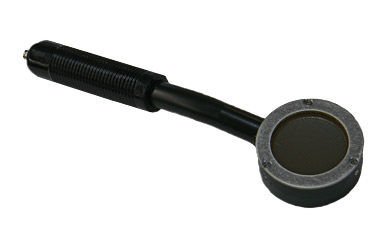General Purpose Radiation Survey

The 2.5 inch pancake G-M probe is ideal for general purpose survey. This G-M probe detects alpha, beta, and gamma radiation. The HP-265 measures 14C, 32P, 35S and 137Cs with notable efficiency. This probe works well with Johnson Nuclear Survey meters and some other instruments.
HP-265 G-M Pancake Probe Specifications
Description: Long life halogen pancake G-M detector with 1.6 mg/cm2 End Window
Efficiency (4pi geometry): Typically 5%-C-14; 22%-Sr-90/Y-90; 19%-Tc-99; 32%-P-32; 15%-Pu-239, Gamma dose to 200 mR/hr (Based on 137Cs
calibration)
OperatingVoltage: 900 vdc
Window Thickness: 1.6mg/cm2
CPM/mR/hr: (137CS): 2,500
Energy Response: 3.5 MeV alpha, 20 MeV gamma, 100 keV beta
Sensitive Area: 15 cm2
Finish: Polyurethane Coated Aluminum
Dimensions: 2.75" dia. X 11" long
Weight: 16 ounces
Environmental: 20º - 60ºC,
5% - 95% RH non-condensing---IPX4
Construction: Polyurethane coated aluminum probe housing, nylon coated stainless steel probe clip
The primary function of the pancake GM is the detection and measurement of beta emitting surface contamination. It also responds to alpha particles and gamma rays.The main components of the geiger-mueller detector are its two collecting electrodes: the anode and cathode (the anode is positively charged with respect to the cathode). The potential difference between the anode and cathode is usually in the 800 to 1200 volt range. The pancake GM tube is a truncated cylinder. One end is covered with a thin mica window. The window thickness is 1.6 mg/cm2.
The gas of a Geiger Mueller detector consists of two components: a fill gas and a quench gas. The fill gas is argon and the quench gas is a halogen gas.
If beta particles or alpha particles get through the detector window, they ionize the fill gas directly. Gamma rays and x-rays ionize the gas indirectly by interacting with the metal wall of the GM (via the photoelectric effect, Compton scattering or pair production) in such a way that an electron is "knocked" off the inner wall of the detector. This electron then ionizes the gas inside the tube.